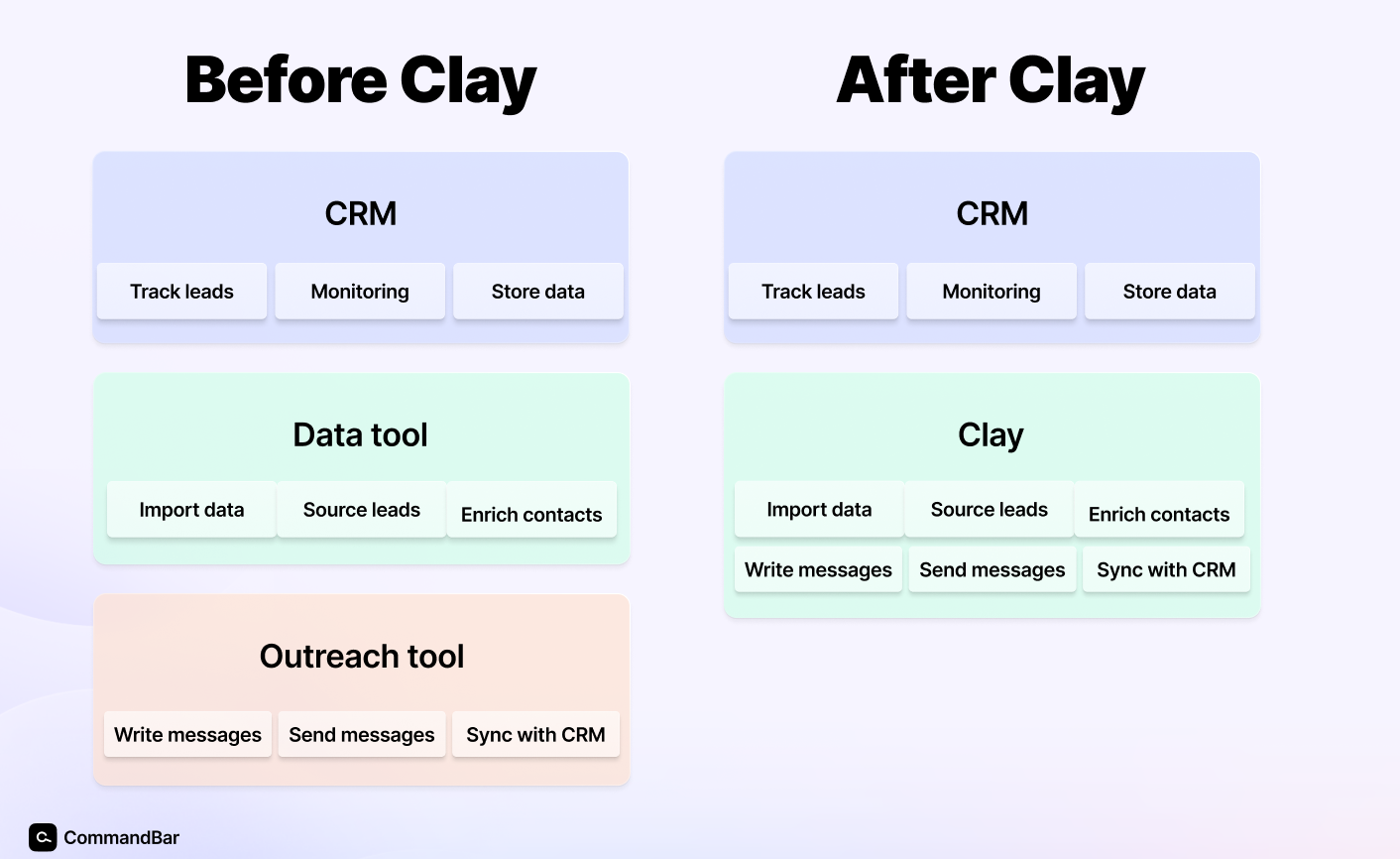The $500m GTM platform: How Clay is reviving outbound sales

“Outbound sales is dead!” “Cold emailing is dead!” “Cold calling is dead!” says every sales LinkedInfluencer and first-time tech founder (seriously, I’m not kidding).
The truth is - bad outbound is dead. The constant barrage of irrelevant emails, annoying LinkedIn messages and spam calls stops many key decision-makers from wanting to participate in a sales process.
As annoying as it is to get yet another request to “hop on a quick call”, nobody wakes up in the morning to annoy you. Salespeople are often paid on commission - they’d prefer to send you valuable things that engage you. But few sales tools enable the level of personalization that would enable this.
So much of that behavior is shaped by the tools salespeople use: If it’s easy to send a sequence of 7 emails 20,000 people, that’s exactly what will happen.
How much of the death of sales can be blamed on mediocre and time-consuming tools being used by sales orgs?
Why sales became so annoying
Many sales organizations struggle with creating hyper-personalized outbound campaigns at scale because no one tool has all the functionalities required for the full sales cycle:
- Run due diligence on prospects
- Write emails for real people (not robots in suits)
- Track the lifecycle of a prospect.
Even scrappy sales orgs use at minimum 5 tools between a CRM, prospecting tool, email tool, lead scoring, automation, etc. These tools are annoying to buy, expensive, and irritating to use.

This type of market signals an opportunity: When a market is fragmented with specialized solutions, an all-in-one player often emerges to create a destination that unites them all.
And for all your trouble, having all these tools doesn’t even guarantee you’ll engage prospects. It just means that you can mass email potential customers like everyone else. Clay wants to fix this.
How Clay revives sales
Prospects get so much bad outreach because research and personalization takes so much time. Salespeople also don’t have a central way to do their job. So they hop from tool to tool, which makes doing quality outreach even more difficult.
This is exactly what Clay set out to fix.
Having just raised a $46million Series B at a $500million valuation, the growth marketing and RevOps tool Clay is the closest thing to 3-in-1 shampoo for sales.
It combines AI lead generation with outreach and CRM maintenance to eliminate tool fatigue and let salespeople look at everything in one place.
Each feature makes life easier for salespeople:
- Clay implements integrations across many data providers that allows anyone to build lists of prospects (bye bye LinkedIn Sales Navigator),
- Clay researches prospects using data and ChatGPT to summarize (which saves so much time).
- Clay actually messages and maintains clean records of prospect interactions within a CRM.
Clay wasn’t originally saving salespeople from clicking more buttons.
In 2017, Clay founders Kareem Amin and Nicolae Rusan wanted to make programming more accessible. They wanted to let people see all their data in one place, which would enable even non-technical users to understand what was going on in any given application. Their vision: A “magic spreadsheet” that populated data from multiple sources in one place.
(for our analysis of spreadsheet startups, read our breakdown of Excel challengers.)
Magic spreadsheet, not a magic company
The best thing about a magic spreadsheet is that anyone can use it. The worst thing about a magic spreadsheet is that anyone can use it.
Before Clay specialized in outbound sales, it struggled with the typical challenge of having “everyone” as your ICP: Much like generic sales outreach, it didn’t feel custom-tailored to anyone.
A product like a magic spreadsheet can have infinite reach: It could help the finance bros build excel models, help recruiters source new leads, etc. But this made it hard to find product-market fit.
That’s why Clay’s success wasn’t immediate. They had first raised funding in 2017, but still stood at nearly $0 in revenue in 2022.
How Clay became a GTM tool
In attempting to address the entire market, Clay ended up with prospects who got excited about the wide use cases, but who used the product inconsistently or completely stopped. After three years of trying to sell to everyone, Amin and Rusan made a vulnerable admission: They needed to focus on one thing.
Outbound sales seemed like a great opportunity: They had used their own product to refine their strategy, so they started to sell to customers trying to construct a similar sales process.
This is another great takeaway: If you’re solving a problem for yourself, there’s a good chance other people like you have the same problem. This is exactly how Amplitude pivoted into analytics.
Solving many people’s problems halfway or solving a specific group of people’s problems really well AND displace a bunch of other competitors is like the tech founder’s prisoner’s dilemma.
Therefore, narrowing down Clay’s ICP meant commitment issues - after much waffling about whether outbound sales made the most sense as an application, the founders took the plunge and modeled what should be a lesson for all founders: They got rid of any language on their website that wasn’t targeted towards the outbound sales motion, cut features that weren’t important for salespeople, and recentered their team on their specific goal of improving outbound sales.
They recognized that modern salespeople have to a) buy access to all of the data to understand their prospects and b) they waste time triangulating this data, updating the CRM, and doing due diligence across many tools.
In their original iteration, Clay started to solve “tool fatigue,” but why stop there? Amin cited discipline and community as the two ways they narrowed in on the features that they actually wanted.
They could have returned to getting overexcited and trying to solve every single problem that plagues outbound sales. Then they would’ve ended up building features nobody uses, with no centralized way to pick out what was actually important to customers.
Instead, the Clay team focused on getting direct input for customers: They cut off unnecessary ways of communicating with customers and unified everyone in Slack. After hearing feedback from their community, they focused on building what was important, rather than what sounded cool (sounds easy but it’s hard).
Clay’s shiny goose egg (read: $0 in revenue) by 2022 took three years to refocus and build in a specific direction, not every direction. This meant they had been “trusting the process” well into 2020.
At the beginning of 2022, they had 120 customers and needed to find more, until they finally launched on Product Hunt in a way that was accessible to more people and grew to 1000+ customers in 2023 after being named Productivity App of the Year.
To make pottery, you have to start with clay.
The main takeaways from this story is that Clay, like clay, had to be malleable and able mold itself to fit a slot instead of stretching thin and covering everything halfway.
Frankly, in looking at case studies for most startups’ product growth, there are two important lessons:
- Creating something people need
- Being able to pivot to fit that need.
This is why VCs see so much promise in companies like Clay and also why they’re willing to give them so much money.
Clay 4x’d the amount they’d raised by their Series A in just one round because they were able to pivot and have faith in their team and their product. They knew there was tool fatigue. If they could create something that could replace even some of them, then they were always going to have buyers.
Clay’s success is not that of the next crazy pre-revenue, pre-product, $100million valuation startup. It is rather a slow burn that listened to customers and created something that really really worked. If there’s one thing you take away from Clay (and to extend the metaphor, pottery), it’s that if you fire an unfinished piece in the kiln it will most likely explode and you’ll have to restart. When clay is unfired, you have the liberty to work on it until it’s perfect and people want to buy it.
